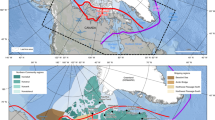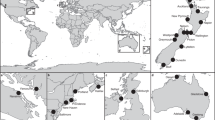Abstract
Understanding climate change impacts on transportation systemsis particularly critical in northern latitudes, where subzero temperatures restrict shipping, but enable passage of ground vehicles over frozen soil and water surfaces. Although the major transport challenges related to climate warming are understood, so far there have been no quantitative projections of Arctic transport system change. Here we present a new modelling framework to quantify changing access to oceans and landscapes northward of 40° N by mid-century. The analysis integrates climate and sea-ice model scenarios1,2 with topography, hydrography, land cover, transportation infrastructure and human settlements. Declining sea-ice concentration and thickness suggest faster travel and improved access to existing (+5 to +28%) and theoretical (+11 to +37%) offshore exclusive economic zones of Canada, Greenland, Russia and the US. The Northern Sea Route, Arctic Bridge and North Pole routes are projected to become fully accessible from July–September, averaging ∼11, 15 and 16 days to traverse, respectively, whereas the Northwest Passage will not. All eight Arctic states are projected to suffer steep declines (−11 to −82%) in accessibility inland, driven by lost potential for winter road construction caused by milder winters and deeper snow accumulation.
This is a preview of subscription content, access via your institution
Access options
Subscribe to this journal
Receive 12 print issues and online access
$209.00 per year
only $17.42 per issue
Buy this article
- Purchase on Springer Link
- Instant access to full article PDF
Prices may be subject to local taxes which are calculated during checkout



Similar content being viewed by others
References
Community Climate System Model 3.0 (National Center for Atmospheric Research, 2004).
Nakicenovic, N. & Swart, R. (eds) IPCC Special Report on Emission Scenarios (Cambridge Univ. Press, 2000).
IPCC Climate Change 2007: The Physical Science Basis (eds Solomon, S. et al.) (Cambridge Univ. Press, 2007).
Anisimov, O. A. et al. in IPCC Climate Change 2007: Impacts, Adaptation and Vulnerability (eds Parry, M. L., Canziani, O. F., Palutikof, J. P., van der Linden, P. J. & Hanson, C. E.) (Cambridge Univ. Press, 2007).
Christensen, J. H. et al. in IPCC Climate Change 2007: The Physical Science Basis (eds Solomon, S. et al.) (Cambridge Univ. Press, 2007).
ACIA Arctic Climate Impact Assessment (Cambridge Univ. Press, 2005).
Smith, L. C. in The World in 2050: Four Forces Shaping Civilization’s Northern Future (Dutton, 2010).
Arctic Marine Shipping Assessment 2009 Report (Arctic Council, 2009).
Maslanik, J. A. et al. A younger, thinner Arctic ice cover: increased potential for rapid, extensive sea-ice loss. Geophys. Res. Lett. 34, L24501 (2007).
Hunke, E. C. & Bitz, C. M. Age characteristics in a multidecadal Arctic sea ice simulation. J. Geophys. Res. 114, C08013 (2009).
Kwok, R. & Rothrock, D. A. Decline in Arctic sea ice thickness from submarine and ICESat records: 1958–2008. Geophys. Res. Lett. 36, L15501 (2009).
Kwok, R. & Cunningham, G. F. Contribution of melt in the Beaufort Sea to the decline in Arctic multiyear sea ice coverage: 1993–2009. Geophys. Res. Lett. 37, L20501 (2010).
Liu, M. & Kronbak, J. The potential economic viability of using the Northern Sea Route (NSR) as an alternative route between Asia and Europe. J. Trans. Geogr. 18, 434–444 (2010).
Somanathan, S., Flynn, P. & Szymanski, J. The Northwest Passage: A simulation. Trans. Res. A 43, 127 (2009).
NSIDC Arctic sea ice falls to third-lowest extent; downward trend persists. National Snow and Ice Data Center (2010); available at http://nsidc.org/news/press/20101004_minimumpr.html.
Pettersen, T. First high-tonnage tanker through Northeast Passage. BarentsObserver.com (17 August 2010).
Nilsen, T. ‘MV Nordic Barents’ makes historic voyage. BarentsObserver.com (26 August 2010).
Pettersen, T. Cargo transport through Northern Sea Route will tenfold. BarentsObserver.com (19 November 2010).
NRTEE True North: Adapting Infrastructure to Climate Change in Northern Canada (National Round Table on the Environment and the Economy, 2009).
Adam, K. M. Building and Operating Winter Roads in Canada and Alaska (Department of Indian and Northern Affairs, 1978).
Hinzman, L. D. et al. Evidence and implications of recent climate change in northern Alaska and other Arctic regions. Clim. Change 72, 251–298 (2005).
Hayley, D. & Proskin, S. Managing the safety of ice covers used for transportation in an environment of climate warming. Presented at the 4th Canadian Conference on Geohazards (Laval Univ., 2008).
Geertman, S. C. M. & van Eck, J. R. GIS and models of accessibility potential: An application in planning. Int. J. Geograph. Inform. Syst. 9, 67–80 (1995).
Taaffe, E. J. Geography of Transportation (Prentice-Hall, 1973).
Deichmann, U. Accessibility indicators in GIS (Department for Economic and Social Information and Policy Analysis, United Nations Statistics Division, 1997).
Nelson, A. Travel Time to Major Cities: A Global Map of Accessibility (Global Environment Monitoring Unit—Joint Research Centre of the European Commission, 2008).
International Boundaries Research Unit. Maritime jurisdiction and boundaries in the Arctic region (Durham Univ., 2008).
Bird, K. J. et al. Circum-Arctic resource appraisal: estimates of undiscovered oil and gas north of the Arctic Circle (US Geological Survey, 2008).
Gautier, D. L. et al. Assessment of undiscovered oil and gas in the Arctic. Science 324, 1175–1179 (2009).
Brigham, L. W. Thinking about the Arctic’s future: Scenarios for 2040. Futurist 41, 27–34 (2007).
Brigham, L. W. Think again: The Arctic. Foreign Policy (September/October 2010).
Streletskiy, D. A., Shiklomanov, N. I. & Grebenets, V. I. Changes of foundation bearing capacity due to climate warming in Northwest Siberia. Earth Cryosphere (in the press).
Smith, L. C., Sheng, Y., MacDonald, G. M. & Hinzman, L. D. Disappearing Arctic lakes. Science 308, 1429 (2005).
Acknowledgements
The authors thank Y. Sheng, V. Chu and E. Lyons (UCLA); Lawson Brigham (University of Alaska, Fairbanks); J. Maslanik (University of Colorado, Boulder); A. Nelson (European Commission); M. Pratt (Durham University); P. Bourbonnais (University of Montreal); R. MacDonald (Transport Canada); C. Adler and C. Milne (Alaska Department of Transportation); E. Madsen (Tibbitt to Contwoyto Winter Road Joint Venture); and L. Purcka (GNWT Department of Transportation) for assistance in the production of this manuscript. This work was supported by the Academic Senate of the University of California, Los Angeles, the NASA Cryosphere Program, and the National Science Foundation Graduate Researchers Fellowship Program (DGE-0707424).
Author information
Authors and Affiliations
Contributions
S.R.S. designed the methodology, performed analyses, and led the writing. L.C.S. designed the methodology, assisted with data interpretation and contributed to writing. J.A.A. assisted with background research on accessibility theory and conducted a critical review of the manuscript.
Corresponding author
Ethics declarations
Competing interests
The authors declare no competing financial interests.
Supplementary information
Supplementary Information
Supplementary Information (PDF 2186 kb)
Rights and permissions
About this article
Cite this article
Stephenson, S., Smith, L. & Agnew, J. Divergent long-term trajectories of human access to the Arctic. Nature Clim Change 1, 156–160 (2011). https://doi.org/10.1038/nclimate1120
Received:
Accepted:
Published:
Issue Date:
DOI: https://doi.org/10.1038/nclimate1120
This article is cited by
-
New insights into projected Arctic sea road: operational risks, economic values, and policy implications
Climatic Change (2023)
-
Toward Quantifying the Increasing Accessibility of the Arctic Northeast Passage in the Past Four Decades
Advances in Atmospheric Sciences (2023)
-
Review of quantitative methods to assess impacts of changing climate and socioeconomic conditions on Arctic transportation systems
Ambio (2023)
-
Impact of 1, 2 and 4 °C of global warming on ship navigation in the Canadian Arctic
Nature Climate Change (2021)
-
Arctic shipping guidance from the CMIP6 ensemble on operational and infrastructural timescales
Climatic Change (2021)



